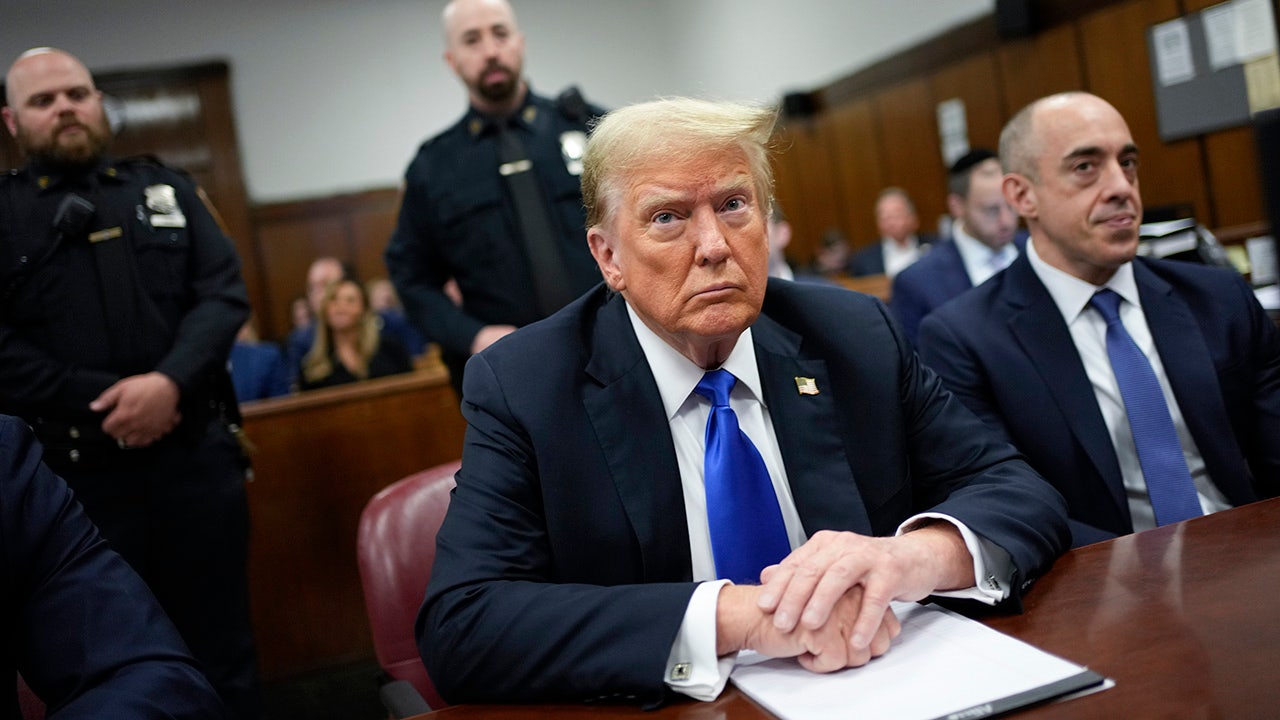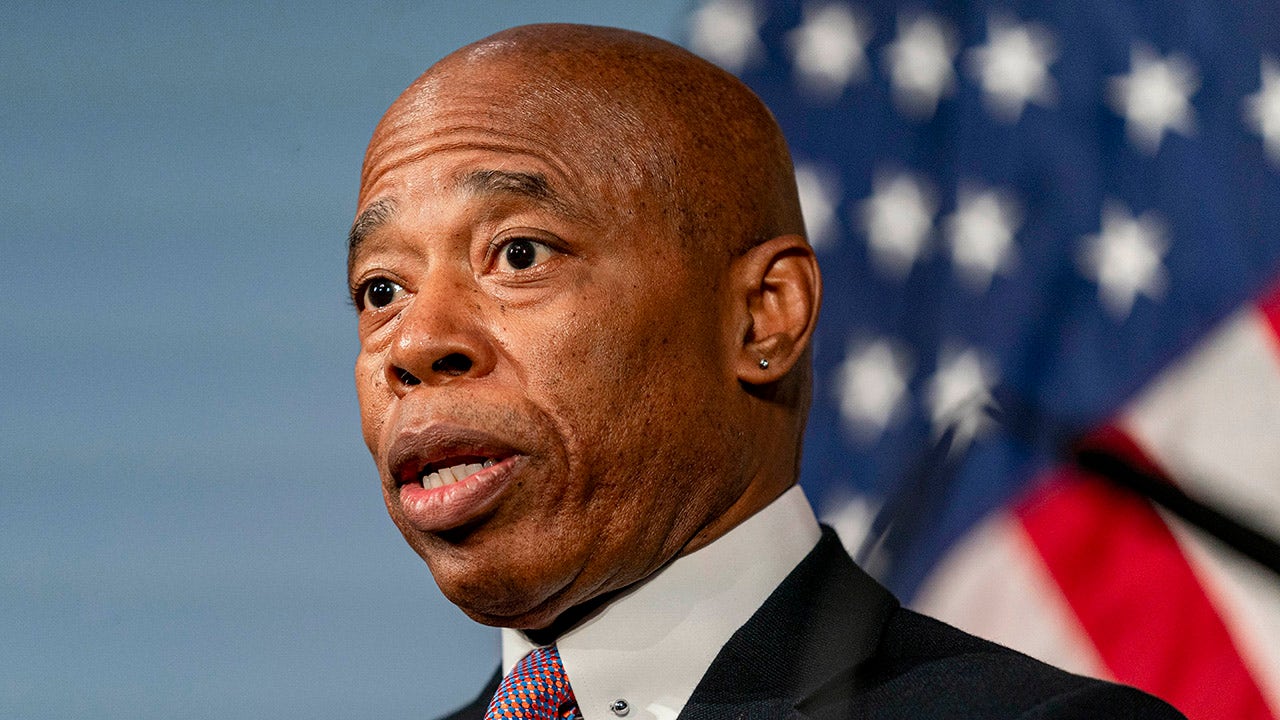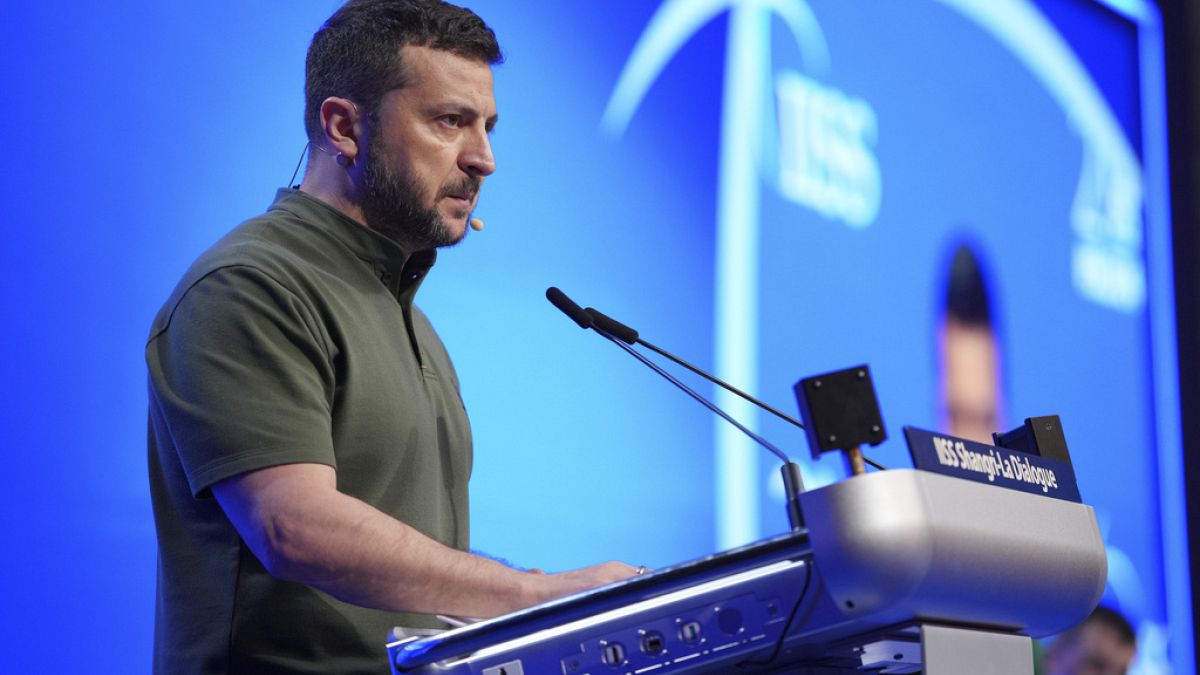World
Denmark turns to Kosovo to alleviate its overcrowded prison system in $217 million deal
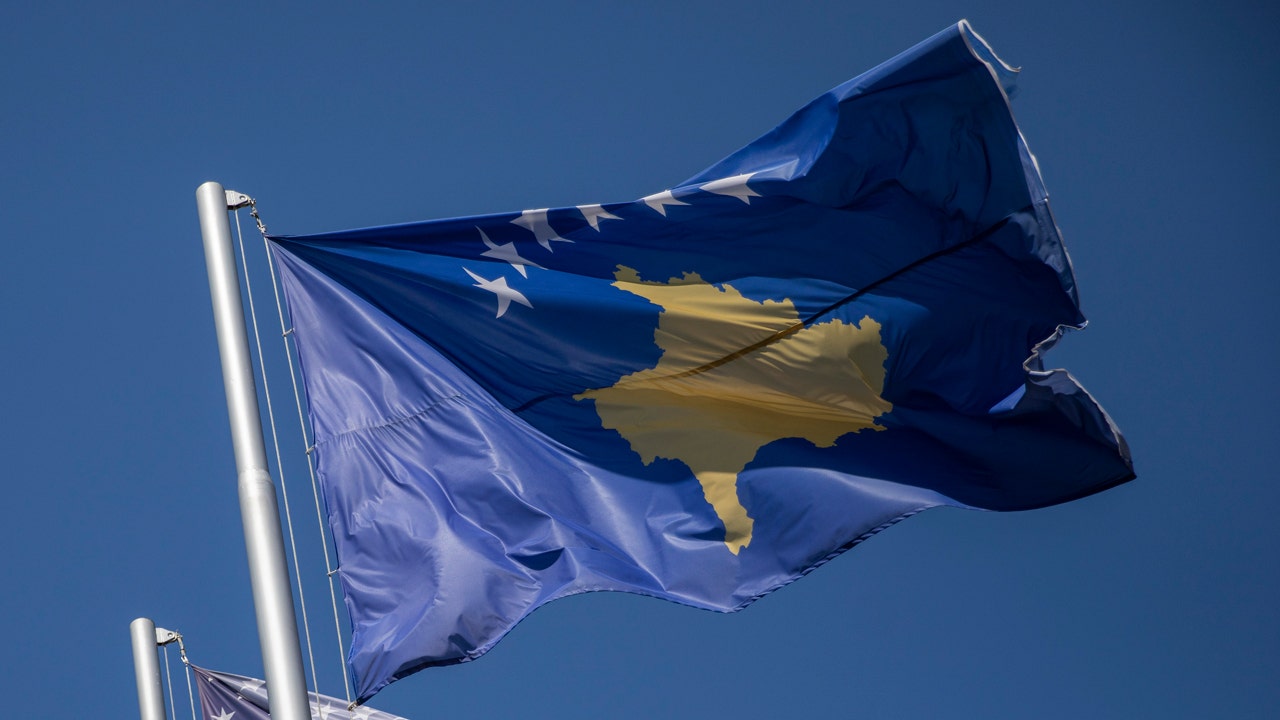
Kosovo’s Cabinet renewed efforts with a new draft law on renting a prison in the south of the country to Denmark to help it cope with its overpopulated prison system, an official said Monday.
The first draft of the law failed to pass at the parliament last week. But on Sunday, the Cabinet approved a draft law on 300 cells at the prison in Gjilan, 50 kilometers (30 miles) south of the capital Pristina, to be rented to Denmark, based on a a 10-year agreement that the two governments signed in April and May 2022, government spokesman Perparim Kryeziu said.
FORMER KOSOVO INFRASTRUCTURE MINISTER GETS 44 MONTHS FOR OVERSPENDING ON ROAD PROJECT
“The Cabinet approved it (the draft law) again yesterday (Sunday) so that it passes on to the Assembly (the parliament) to be voted on again,” he said.
An official in Kosovo says the Cabinet has renewed efforts with a new draft law on renting a prison in the south of the country to Denmark to help it cope with its overpopulated prison system. (Photo by Ferdi Limani/Getty Images)
Last week, the draft law got 75 votes, not reaching at least 80, or two-thirds of the 120-seat parliament as required to pass.
Kosovo will be paid 200 million euros ($217 million) that will be spent on the country’s correctional institutions and renewable energy projects.
According to the plan, Denmark won’t be able to send inmates convicted of terrorism or war crimes, or mentally ill prisoners. A Danish warden will run the 300-cell facility, accompanied by an Albanian one and other local staff.
Kosovo’s prison system has a capacity of up to 2,800. It wasn’t immediately possible to find out the current number of vacancies.
Neighboring Albania has agreed to hold thousands of asylum-seekers for Italy.

World
After crackdown on Hong Kong, overseas communities carry the torch to keep Tiananmen memories alive
HONG KONG (AP) — As the 35th anniversary of Beijing’s Tiananmen Square crackdown neared, Rowena He, a prominent scholar of that bloody chapter of modern China’s history, was busy flying between the United States, Britain and Canada to give a series of talks. Each was aimed at speaking out for those who cannot.
The 1989 crackdown, in which government troops opened fire on student-led pro-democracy protesters, resulting in hundreds, if not thousands, dead, remains a taboo subject in mainland China. In Hong Kong, once a beacon of commemorative freedom, the massive June 4 annual vigil that mourned the victims for decades has vanished, a casualty of the city’s clampdown on dissidents following huge anti-government protests in 2019.
He was still reeling from the loss of her academic position after Hong Kong authorities last year rejected her visa renewal, widely seen as a sign of the financial hub’s decline in intellectual freedom. Despite the exhausting schedule of talks, the former protester in the southern Chinese city of Guangzhou in 1989 viewed this as her duty.
“We cannot light the candles in Hong Kong anymore. So we would light it everywhere, globally,” she said.
As Beijing’s toughened political stance effectively extinguished any large-scale commemorations within its borders, overseas commemorative events have grown increasingly crucial for preserving memories of the Tiananmen crackdown. Over the past few years, a growing number of talks, rallies, exhibitions and plays on the subject have emerged in the U.S., Britain, Canada, Australia and Taiwan.
These activities foster hope and counteract the aggressive efforts to erase reminders of the crackdown, particularly those seen in Hong Kong. In 2021, the city’s police charged three leaders of the group that organized the vigil with subversion under a 2020 sweeping national security law that has all but wiped out public dissent. Later, the group voted to disband. Tiananmen-related statues were also removed from universities.
Last week, under a new, home-grown security law, Hong Kong police arrested seven people on suspicion of alleged sedition over their posting of social media content about commemorating the Tiananmen crackdown. A Christian newspaper, which typically publishes content related to the event ahead of its anniversary, left its front page mostly blank. It said it could only turn words into blank squares and white space to respond to the current situation.
On Tuesday, the park that used to hold the vigil will be occupied by a carnival held by pro-Beijing groups.
However, attempts to silence commemorative efforts have failed to erase the harrowing memories from the minds of a generation of liberal-minded Chinese in the years after tanks rolled into the heart of Beijing to break up weeks of student-led protests that had spread to other cities and were seen as a threat to Communist Party rule.
He, who was 17 years old at the time, recalls that protesters like her took to the streets out of love for their country. When the crackdown happened, she spent the entire night in front of her TV, unable to sleep. After she returned to school, she was required to recite the official narrative — that the government had successfully quelled a riot — in order to pass her exams.
“I never killed anyone. But I lived with that survivor’s guilt all those years,” she said.
To preserve memories of the event, a museum dedicated to the Tiananmen crackdown opened in New York last June. It features exhibits such as a blood-stained shirt and a tent used by student protesters.
A similar museum operated by vigil organizers was shuttered in Hong Kong in 2021.
As of early May, its board chair Wang Dan, also a leading former student leader of the Tiananmen protests, estimated the New York museum attracted about 1,000 people, including Chinese immigrants, U.S. citizens and Hong Kongers. To expand its audience, Wang said he plans to organize temporary exhibitions on university campuses in the U.S., and possibly in other countries over the longer term.
He said overseas memorial events are crucial because mainland Chinese and Hong Kongers can see overseas memorial activities online.
“It can have an effect in mainland China because young people there all know how to use VPNs to circumvent internet censorship,” he said.
Aline Sierp, a professor of European history and memory studies at Maastricht University in the Netherlands, said overseas commemorative activities allow the memories to travel and endure, providing access for other people and future generations.
But she said it can be “a double-edged sword” because adapting the memories to new places might risk fragmenting or de-contextualizing them in the future.
Alison Landsberg, a memory studies scholar at George Mason University in Virginia, said that overseas efforts carry the potential to inspire people from other places who are facing their own challenges in the pursuit of democracy.
To carry the memories forward, film and television dramas can be powerful tools for people to take on memories of events through which they didn’t live, she said.
She said overseas theater productions about the crackdown, which began last year in Taiwan and continued in London this year, have a greater possibility of making those connections and potentially reaching a broader audience.
“When you have a dramatic narrative, you have the capacity to bring the viewer into the story in a kind of intimate way,” Landsberg said.
Last week, members of an audience at a London theater were visibly moved, some to tears, after watching the play “May 35th,” a title that subtly references the June 4 crackdown.
The play, produced by Lit Ming-wai, part of the Hong Kong diaspora who moved to the U.K. after the enactment of the 2020 security law, tells the story of an elderly couple who wish to properly mourn their son who died in 1989.
Its director, Kim Pearce, who was born in the U.K. in the 1980s, said the tragedy had resonated with her from a young age and she was once moved to tears when she read the poem “Tiananmen” by James Fenton. Working on this project, she said, has further deepened her connection to the stories.
British theater-goer Sue Thomas, 64, also found the play deeply moving. “Particularly as a parent myself now, which I wasn’t then, which sort of made me think of it in a much more sort of heartfelt way,” she said.
At the theater, He, the scholar, served as one of the post-show speakers, sharing her struggles and the motivations behind her work with the audience. She said the play was so powerful that it made her relive the trauma of the past 35 years, leaving her in tears and causing her to lose her contact lenses.
“It shows that how much sufferings that people had to endure all these years,” she said. “If there’s anything we can do, I hope that we would bring the younger generation to understand this.”
___
Ji reported from London.
World
Radical climate activist vandalizes famous painting in Paris
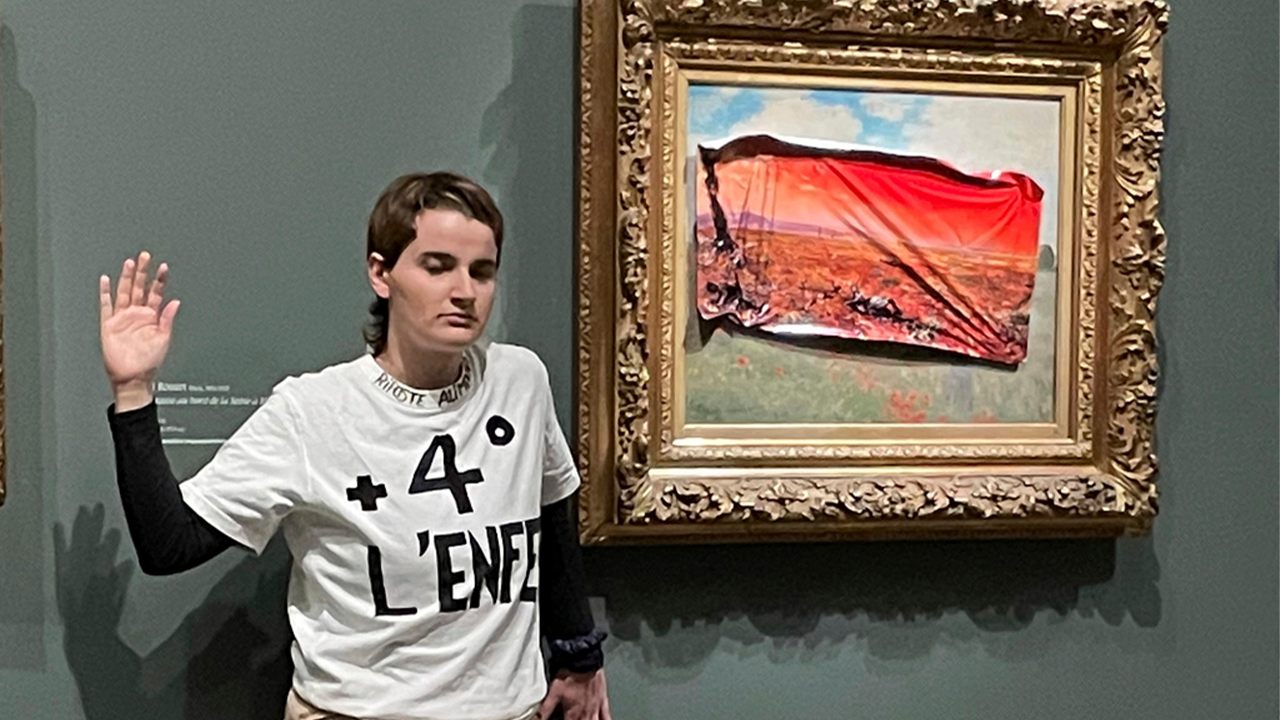
Paris authorities arrested a radical climate protester Saturday after she vandalized a famous painting by Claude Monet at the Orsay Museum.
The protester, who was part of the French environmental activist group, Riposte Alimentaire, targeted Monet’s 1973 painting “Les Coquelicots” by covering it with a large red sticker and gluing her hand to the wall.
This photo provided by Riposte Alimentaire shows an environmental activist posing by “Poppy Field” by Claude Monet at the Orsay museum, Saturday, June 1, 2024 in Paris. (Riposte Alimentaire via AP)
The red sticker depicted an apocalyptic, futuristic vision of the same scene. Riposte Alimentaire, which translates to “Food Response,” in French, said the scene is supposed to show what the field would look like in 2100, “ravaged by flames and drought,” if more action isn’t taken against climate change.
YOUTH-LED CLIMATE CHANGE LAWSUITS GAIN MOMENTUM WITH BACKING OF LIBERAL, DARK MONEY GROUP
The woman was detained pending investigation, according to Paris police. It was unclear whether the incident damaged the painting.
Saturday marked the latest actions by protesters with Riposte Alimentaire, targeting artworks in France in calls for action to protect food supplies from further damage to the climate.
The museum, known in French as the Musée d’Orsay, is a top tourist destination and home to some of the world’s most-loved Impressionist works.
The Associated Press contributed to this report.
World
Mexico election live results 2024: By the numbers

Mexico has begun to count votes after a Sunday election that will almost certainly result in the country’s first female president.
The two frontrunners are Claudia Sheinbaum of the ruling Morena party, supported by the governing coalition Let’s Keep Making History (Sigamos Haciendo Historia), and Xochitl Galvez, supported by a coalition of opposition parties.
Jorge Alvarez Maynez, a third candidate, is running on behalf of the Citizens’ Movement.
As the first few votes started trickling in, Sheinbaum grabbed an early lead, followed by Galvez, in keeping with opinion polls that placed the Morena candidate as the firm favourite to win the presidency.
In addition to the presidency, voters also cast their ballots for about 20,000 positions in what is the country’s largest-ever election.
According to Mexico’s National Electoral Institute (INE), these positions include 128 Senate seats, 500 deputy seats, the governorship of Mexico City, and governorships in eight states including Chiapas, Guanajuato, Jalisco, Morelos, Puebla, Tabasco, Veracruz and the Yucatan.
Here is how the three parties are performing in the presidential vote, according to the latest updates from the INE:
When will we know the final results?
The results will likely be finalised only by June 8.
However, on June 2, Mexicans will have access to the quick count, a statistical projection estimating voting trends from a random sample of 7,500 polling stations.
Between 10pm and 11pm (starting at 03:00-04:00 GMT) on June 2, the INE will announce the quick count results of the presidential election. This announcement will be delivered in a televised message broadcast nationwide.
Starting at 8pm (02:00 GMT) on Sunday, the INE will also launch the Preliminary Electoral Results Program (PREP), a system that gathers and publishes data recorded by polling station officials. Al Jazeera will be relying on this data for its vote count tracker, while also sharing the quick count when it is announced by election officials.
When will the new president take charge of Mexico?
Mexico’s newly-elected president will be inaugurated on October 1, 2024, four months after election day.
This marks the first time the inauguration will occur on October 1 instead of December 1, following a change in the electoral law in 2014.
Besides the presidency, what other races are closely watched?
Other than who will be the next leader of the country, the race for Congress remains key.
The ruling party Morena aims to achieve a two-thirds majority in Congress, important for revising the constitution and eliminating what it perceives as cumbersome and wasteful oversight agencies. The opposition, united in a loose coalition, says this action would pose a threat to Mexico’s democratic institutions.
This could also affect the peso and how investors react to the election.
“If [Morena] wins two-thirds of the Congress, or gets eerily close, that becomes a tougher decision for investors because that becomes a very different scenario, in which there’s less constraints to power,” Miguel Angel Toro Rios, the dean of the School of Social Sciences and Government at Tecnologico de Monterrey, told Al Jazeera.
In Mexico City, the competition is fierce, with Clara Brugada of the ruling party, Santiago Taboada of the largest opposition coalition and Salomon Chertorivski of the Citizens’ Movement all locked in a tight race.
Governorships in large, populous states such as Veracruz and Jalisco are also drawing interest.
-

 News1 week ago
News1 week agoRead the I.C.J. Ruling on Israel’s Rafah Offensive
-

 News1 week ago
News1 week agoVideo: Protesters Take Over U.C.L.A. Building
-

 World1 week ago
World1 week agoHoping to pave pathway to peace, Norway to recognise Palestinian statehood
-

 News1 week ago
News1 week agoLegendary U.S. World War II submarine located 3,000 feet underwater off the Philippines
-

 World1 week ago
World1 week agoFamilies of Uvalde school shooting victims sue Microsoft, Meta and gunmaker
-

 Politics1 week ago
Politics1 week agoDefense Secretary Lloyd Austin to undergo nonsurgical procedure, Deputy Kathleen Hicks will assume control
-

 Politics1 week ago
Politics1 week agoHunter Biden attends pre-trial hearing in Delaware court on federal gun charges
-

 News1 week ago
News1 week agoHere are three possible outcomes in the Trump hush money trial : Consider This from NPR











